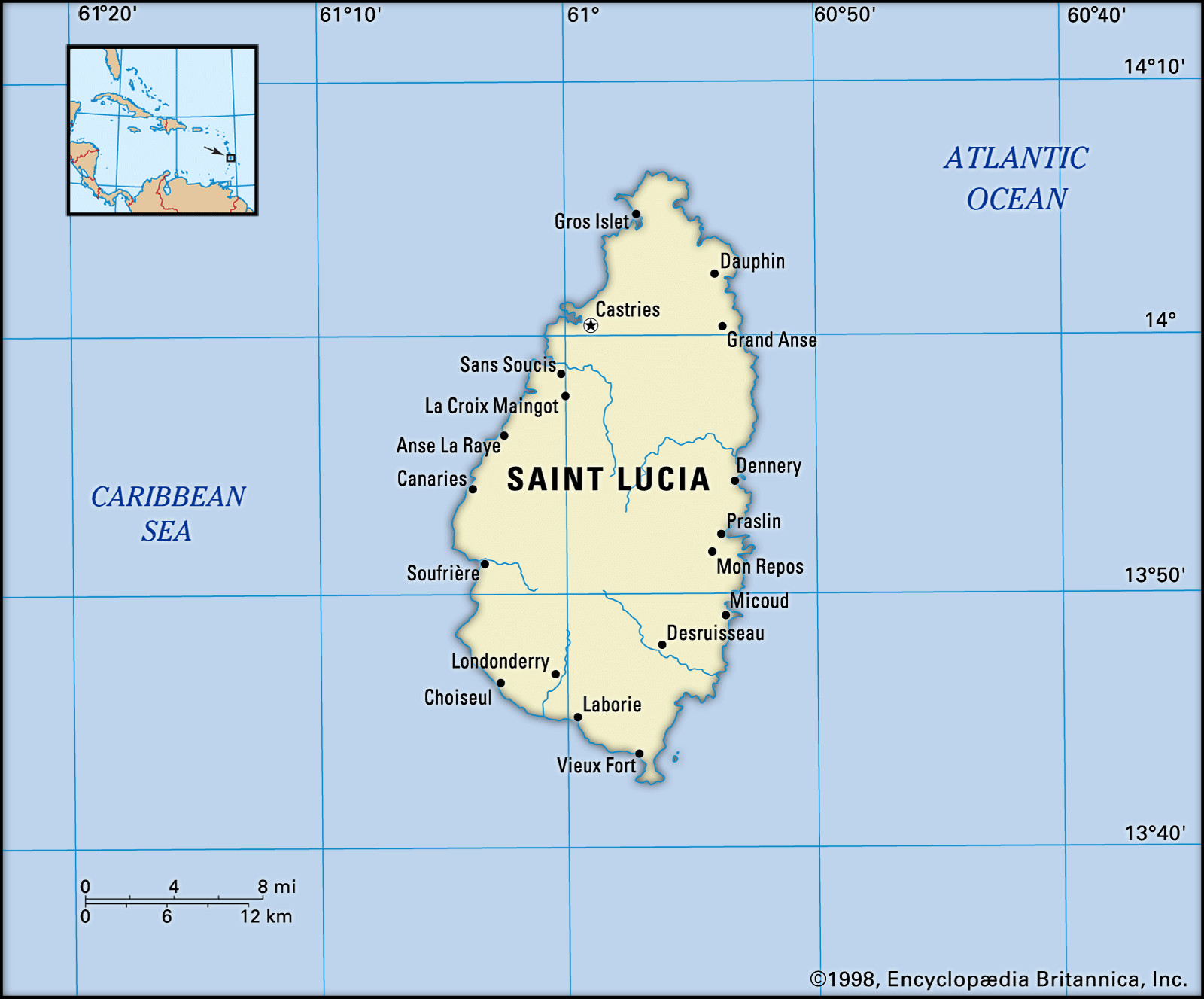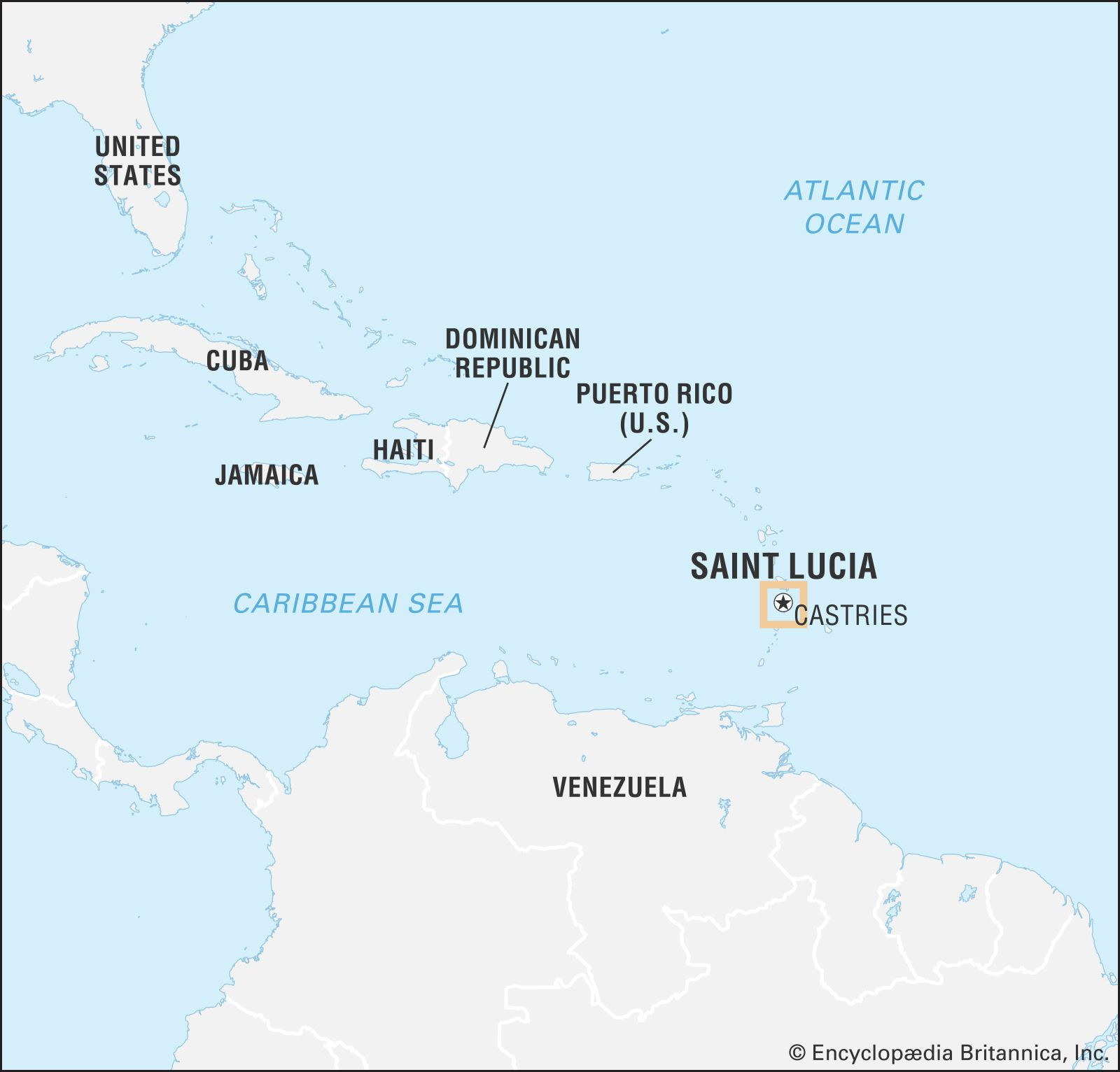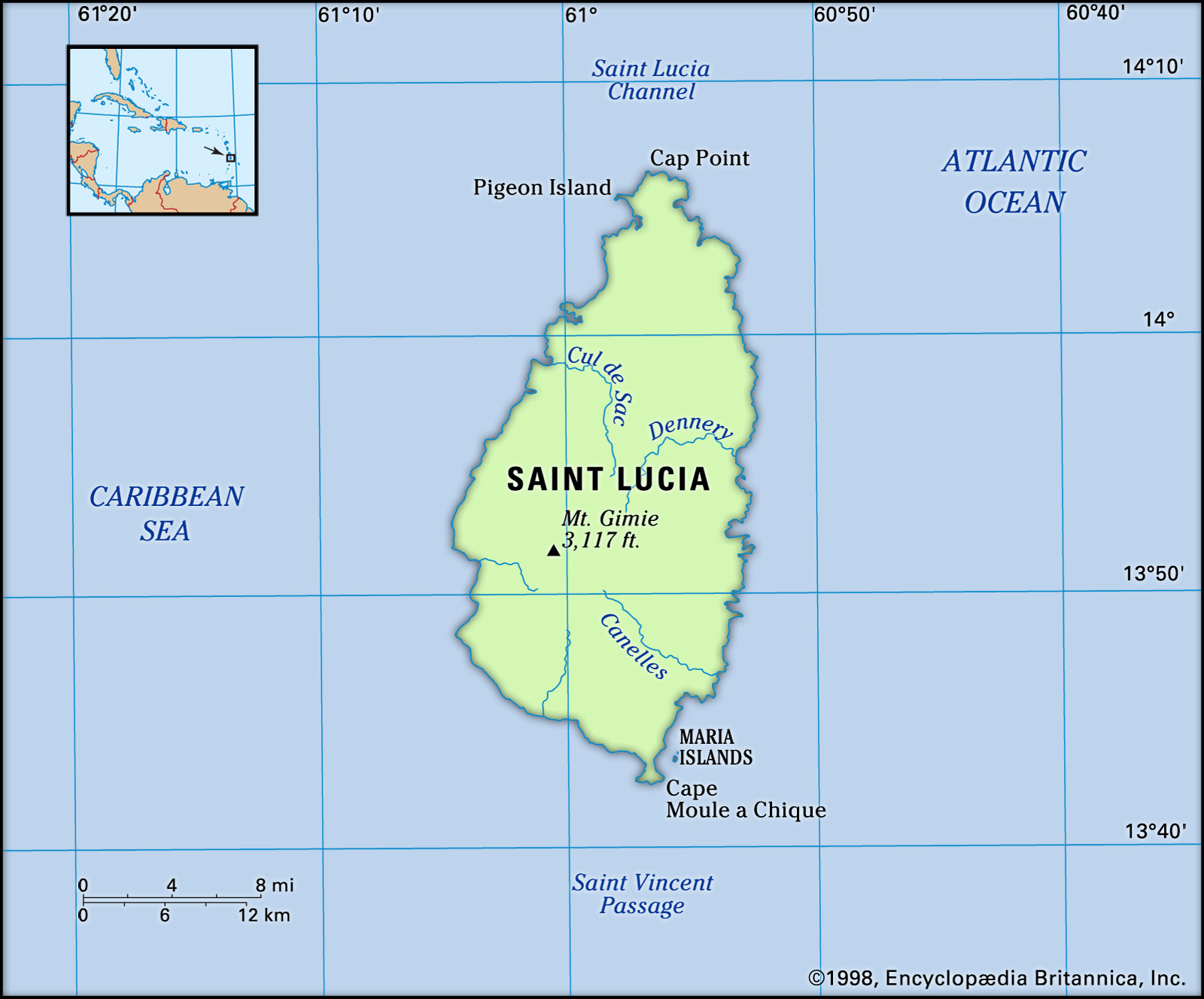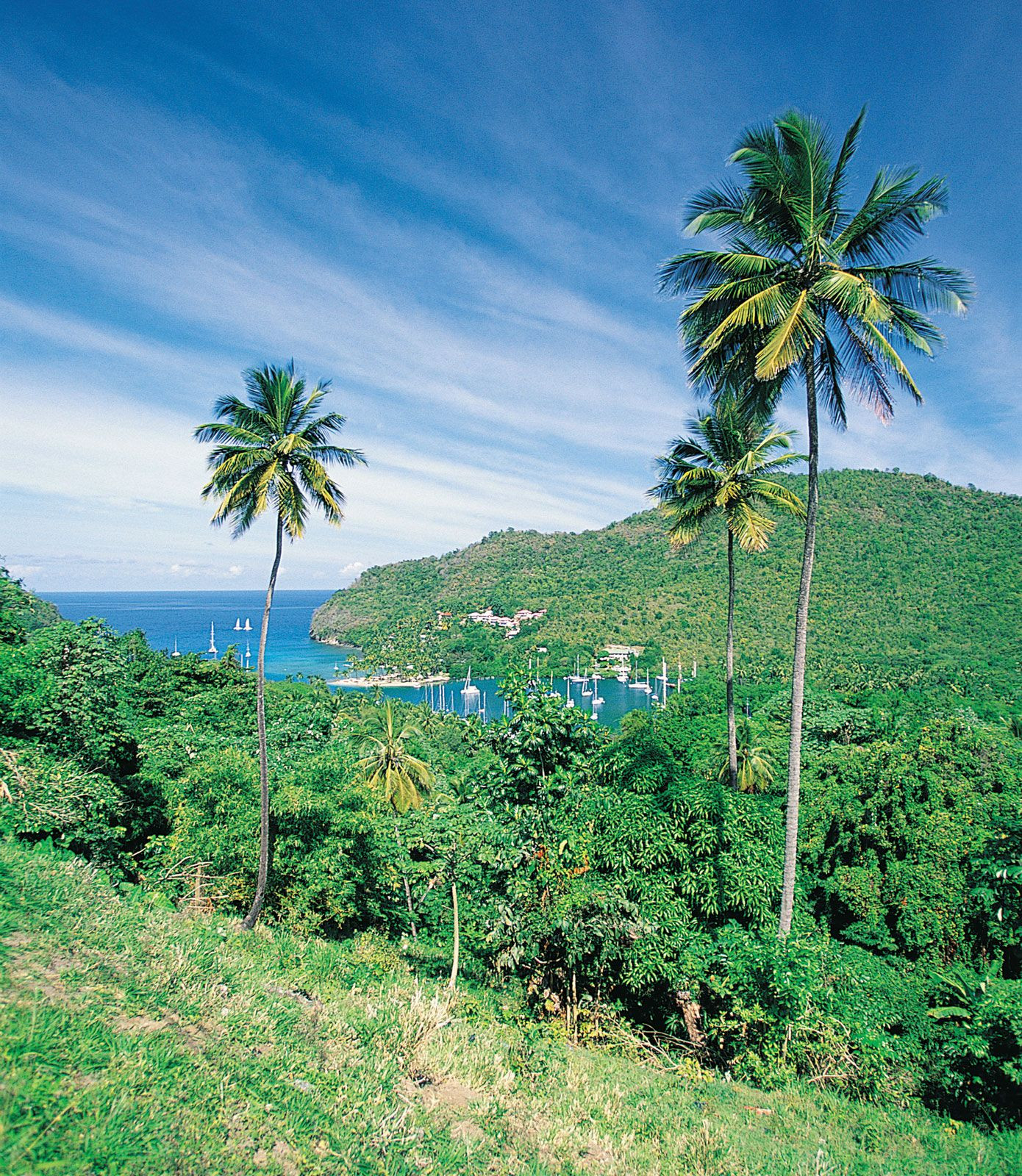Saint Lucia, a jewel of the Caribbean, beckons travelers with its stunning landscapes, vibrant culture, and rich history. But before you pack your bags for this idyllic island paradise, you might be wondering: Where Is Saint Lucia Located? This article will delve into the precise location of Saint Lucia, exploring its geographical context within the Caribbean and highlighting what makes its setting so unique.
 Saint Lucia
Saint Lucia
A detailed locator map showcasing the boundaries and cities of Saint Lucia, positioned in the eastern Caribbean Sea.
Saint Lucia’s Caribbean Setting
Saint Lucia is nestled in the eastern Caribbean Sea, a region famed for its breathtaking islands and crystal-clear waters. Specifically, Saint Lucia is part of the Windward Islands, a southern group within the Lesser Antilles archipelago. This chain of islands arcs gracefully through the Caribbean, forming the eastern boundary of the Caribbean Sea itself. The Windward Islands, known for their lush volcanic landscapes and exposure to trade winds, include other notable islands like Dominica to the north and Saint Vincent and the Grenadines to the south.
To get even more precise, Saint Lucia sits between the islands of Martinique and Saint Vincent. If you were sailing south from Martinique, you would encounter Saint Lucia approximately 24 miles (39 kilometers) to the south. Conversely, if you were traveling northeast from Saint Vincent, Saint Lucia would be about 21 miles (34 kilometers) away. This strategic location places Saint Lucia at the heart of the Eastern Caribbean, making it a convenient and desirable destination for travelers exploring this beautiful part of the world.
 Saint Lucia
Saint Lucia
A world data locator map pinpointing the precise location of Saint Lucia within the global context, emphasizing its position in the Caribbean region of the Atlantic Ocean.
Pinpointing Saint Lucia on the Map
For those who prefer geographical coordinates, Saint Lucia is located roughly at 13.9094° N latitude and 60.9789° W longitude. Imagine a globe; Saint Lucia is situated just north of the equator in the western hemisphere. Its island neighbors in the immediate vicinity include Martinique to the north-northwest and Saint Vincent and the Grenadines to the south-southwest. Other nearby Caribbean nations, although slightly further afield, include Barbados to the east and Grenada to the south.
Saint Lucia’s location within the Windward Islands also means it experiences the consistent northeastern trade winds. These winds play a crucial role in shaping the island’s climate, bringing refreshing breezes and contributing to the tropical maritime conditions that make it so appealing. Furthermore, its position within the Lesser Antilles places it in a volcanically active zone, contributing to the island’s dramatic landscapes, fertile soils, and even unique attractions like the Sulphur Springs near Soufrière.
Exploring Saint Lucia’s Island Geography
Saint Lucia itself is a relatively small island, measuring approximately 27 miles (43 kilometers) in length and having a maximum width of 14 miles (23 kilometers). Despite its compact size, the island boasts a remarkably diverse topography. A central ridge of mountains runs north to south, cloaked in lush rainforest and culminating in Mount Gimie, the island’s highest peak at 3,145 feet (959 meters). These mountains give rise to numerous streams that cascade through fertile valleys, creating a landscape of dramatic beauty.
The southwestern coast of Saint Lucia is particularly iconic, dominated by the Gros Piton and Petit Piton. These two volcanic plugs rise majestically from the sea, creating natural pyramids that have become symbols of Saint Lucia. Nestled between these Pitons is a stunning bay, offering breathtaking views and excellent opportunities for diving and snorkeling. Adding to the volcanic character of the island, near Petit Piton lies the Sulphur Springs, a geothermal area within a volcanic crater, a testament to the island’s fiery origins and a popular tourist attraction. Castries, the capital city and major port of Saint Lucia, is located on the northwestern coast, serving as a bustling hub of activity and a gateway for visitors arriving by sea and air.
 Marigot Bay, Saint Lucia
Marigot Bay, Saint Lucia
An aerial view of the picturesque Marigot Bay in Saint Lucia, showcasing its sheltered harbor and surrounding lush greenery, a prime example of the island’s coastal beauty.
 Saint Lucia
Saint Lucia
A map detailing the physical features of Saint Lucia, highlighting its mountainous terrain, river systems, and key geographical landmarks across the island.
 Saint Lucia: tropical vegetation
Saint Lucia: tropical vegetation
Lush tropical vegetation covering the hillsides overlooking Marigot Bay, Saint Lucia, illustrating the island’s fertile environment and vibrant ecosystems.
Climate and When to Visit Saint Lucia
Saint Lucia’s tropical maritime climate, influenced by its location and the trade winds, ensures warm temperatures year-round. Average temperatures hover around 80°F (27°C), making it a consistently inviting destination. The island experiences a drier season generally from January to April, and a wetter season from May to November. Rainfall varies across the island, with coastal areas receiving around 51 inches (1,295 mm) annually, while the mountainous interior can see up to 150 inches (3,810 mm).
For those seeking the driest and sunniest conditions, the months from December to April are generally considered the best time to visit Saint Lucia. However, even during the rainy season, showers are often brief and followed by sunshine, and the lush landscapes are at their most vibrant. Regardless of when you choose to travel, Saint Lucia’s location within the tropics guarantees a warm and inviting climate, perfect for enjoying its beaches, rainforests, and outdoor activities.
Conclusion: Discovering Saint Lucia’s Allure
In conclusion, Saint Lucia is located in the eastern Caribbean Sea, within the Windward Islands of the Lesser Antilles, positioned between Martinique and Saint Vincent. Its precise geographical coordinates place it firmly in the tropics, benefiting from warm weather, trade winds, and volcanic activity that has sculpted its dramatic landscape. This location not only defines its climate and geography but also contributes to its rich biodiversity and cultural heritage. Understanding where Saint Lucia is located is the first step in appreciating the unique charm and appeal of this captivating Caribbean island, a destination that promises an unforgettable escape for every traveler.
